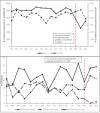COVID-19: A new barrier to treatment for opioid use disorder in the emergency department
- PMID: 33748808
- PMCID: PMC7967916
- DOI: 10.1002/emp2.12403
COVID-19: A new barrier to treatment for opioid use disorder in the emergency department
Abstract
Objective: Start Treatment and Recover (STAR) is an emergency department (ED) program that expands access to medication for opioid use disorder by identifying patients with opioid use disorder and offering ED-initiated buprenorphine/naloxone and rapid access to outpatient treatment. We sought to determine the impacts of the coronavirus disease 2019 pandemic on STAR and the patients with opioid use disorder it serves.
Methods: We conducted a retrospective review of records comparing 2 periods: pre-pandemic (February 1, 2019-February 29, 2020) and pandemic (March 1, 2020-May 31, 2020). Variables evaluated included the number of STAR enrollments, ED census, percentage of census screening positive for opioid use disorder, number and percentage of ED overdose visits, and overdose fatalities by month. All analyses were conducted using 2-sample t tests to calculate the mean and 95% confidence intervals (CIs).
Results: Comparing the pre-pandemic to the pandemic period, the mean monthly ED visits decreased from 5126.9 to 3306.7 (difference = -1820.3; 95% CI, -3406.3 to -234.2), STAR mean monthly enrollments decreased from 9.7 to 1.3 (difference = -8.4; 95% CI, -12.8 to -4.0), and statewide monthly opioid-related fatalities increased from 9.4 to 15.3 (difference = 5.9; 95% CI, 0.8 to 11.1). However, the percentage of individuals who presented to the ED with opioid use disorder or overdose remained unchanged.
Conclusion: Although overall ED visits declined during the pandemic period, the percentage of patients presenting with opioid use disorder or overdose remained constant, yet there was a dramatic decline in enrollment in ED-initiated medication for opioid use disorder and an increase in statewide monthly opioid-related fatalities. Strategies to maintain medication for opioid use disorder treatment options must be implemented for this vulnerable population during the ongoing pandemic.
Keywords: COVID‐19; buprenorphine naloxone drug combination; emergency departments; opioid medication assisted treatment; opioid use disorder; opioid‐related disorders; vulnerable populations.
© 2021 The Authors. JACEP Open published by Wiley Periodicals LLC on behalf of American College of Emergency Physicians.
Conflict of interest statement
The authors declare no conflict of interest.
Figures


References
-
- Advocacy Resource Center . Issue Brief: Reports of Increases in Opioid‐related Overdose and Other Concerns during COVID Pandemic. Washington, DC: American Medical Association; 2020.
LinkOut - more resources
Full Text Sources
Other Literature Sources
